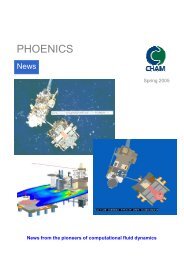PHOENICS - Arcofluid
PHOENICS - Arcofluid
PHOENICS - Arcofluid
Create successful ePaper yourself
Turn your PDF publications into a flip-book with our unique Google optimized e-Paper software.
<strong>PHOENICS</strong><br />
News<br />
Velocity Vector taken at<br />
Several Intake Channel<br />
Sections<br />
One proposed alternative<br />
is to route the ash pond<br />
discharge into the<br />
condenser cooling water<br />
discharge, where it would<br />
be fully mixed and diluted.<br />
The estimated cost for this option is about 8 million<br />
dollars. A less costly proposed alternative, costing about<br />
500 thousand dollars, is to discharge from the ash pond<br />
through a diffuser system added onto the existing<br />
discharge pipes to enhance mixing and dilution in the<br />
intake channel.<br />
Diffusers Angled at 45<br />
degree, Instantaneous<br />
Mixing<br />
A detailed modeling study<br />
of the intake channel flow<br />
patterns was carried out<br />
to optimize the design of<br />
the diffuser system to<br />
facilitate instantaneous<br />
mixing in the intake channel, maximize dilution, and thus,<br />
bring the ammonia (NH3) concentration to acceptable<br />
levels in the intake channel. The modeling results show<br />
an instantaneous mixing and reduction in NH3 to about<br />
0.23 Mg/L within 140 feet downstream the diffusers,<br />
concentration well below the Criteria Continuous<br />
Concentration (CCC) of 0.55 mg/L for KIF intake channel.<br />
Model Layout (Base Case)<br />
Summer 2008<br />
The modeling of the alternative layouts was evaluated under<br />
summer pool elevation with a relatively strong thermal<br />
stratification and a relatively high DO content only in the<br />
upper few feet of the reservoir. <strong>PHOENICS</strong> was used to<br />
evaluate the flow field, water temperature, and DO<br />
improvements. Turbulence was accounted for by using the<br />
K-E turbulence model, and the Boussinesq approximation<br />
was used to include the domain buoyancy effects. The<br />
report presents the modeling results of surface water pump<br />
designs, locations, and operating speeds under summer pool<br />
reservoir elevation for three and six pump layouts<br />
.<br />
Computed Temperature at Intake Vertical Centerline (Six<br />
Pumps)<br />
3. TVA’s Tims Ford Reservoir Surface Water<br />
Pumps<br />
The report describes the numerical simulation of surface<br />
water pump performance at Tims Ford Dam. The modeling<br />
objective was to evaluate surface water pumps<br />
performance under several configurations, pump sizes, and<br />
initial propeller velocities.<br />
Surface-water pumps being ssed at Douglas and<br />
Cherokee Reservoirs<br />
Computed DO at Intake Vertical Centerline (Six Pumps)<br />
The goal was to determine an optimum design to maximize<br />
the improvement of water temperature and dissolved<br />
oxygen (DO) content in hydropower plant releases without<br />
disturbing reservoir bottom sediment. The results for two<br />
alternatives are presented; a three 12-ft pump and a six 8-ft<br />
pump layout.<br />
Based on the comparison of several surface pumps layout<br />
scenarios, the recommended option of surface water<br />
pumps for Tims Ford Forebay Reservoir is the six 8-ft<br />
pump layout. Under the June 26, 2003, forebay profile,<br />
this option improved the water temperature release by<br />
10.3°F and the DO by 2.0 mg/L.<br />
Boualem (Bo) Hadjerioua<br />
Email: bhadjerioua@tva.gov<br />
News from the pioneers of computational fluid dynamics 6








